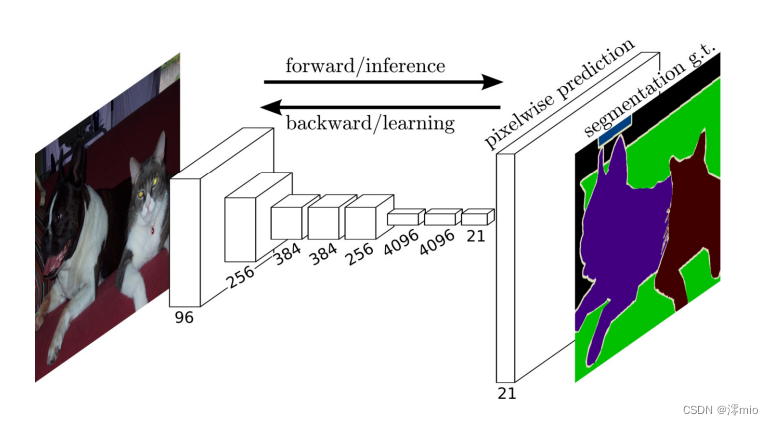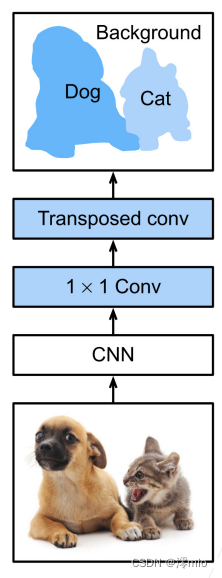前言
核心内容来自博客链接1博客连接2希望大家多多支持作者
本文记录用,防止遗忘
计算机视觉——全卷积网络
课件

FCN
- FCN是用深度神经网络来做语义分割的奠基性工作
- 它用转置卷积层来替换CNN最后的全连接层,从而可以实现每个像素的预测

教材
如语义分割与数据集一节中所介绍的那样,语义分割是对图像中的每个像素分类。 全卷积网络(fully convolutional network,FCN)采用卷积神经网络实现了从图像像素到像素类别的变换。 与我们之前在图像分类或目标检测部分介绍的卷积神经网络不同,全卷积网络将中间层特征图的高和宽变换回输入图像的尺寸:这是通过在转置卷积一节中引入的转置卷积(transposed convolution)实现的。 因此,输出的类别预测与输入图像在像素级别上具有一一对应关系:通道维的输出即该位置对应像素的类别预测。
%matplotlib inline
import torch
import torchvision
from torch import nn
from torch.nn import functional as F
from d2l import torch as d2l
1 构造模型
下面我们了解一下全卷积网络模型最基本的设计。 如图所示,全卷积网络先使用卷积神经网络抽取图像特征,然后通过
1
×
1
1\times 1
1×1卷积层将通道数变换为类别个数,最后通过转置卷积层将特征图的高和宽变换为输入图像的尺寸。 因此,模型输出与输入图像的高和宽相同,且最终输出通道包含了该空间位置像素的类别预测。

下面,我们使用在ImageNet数据集上预训练的ResNet-18模型来提取图像特征,并将该网络记为pretrained_net。 ResNet-18模型的最后几层包括全局平均汇聚层和全连接层,然而全卷积网络中不需要它们。
pretrained_net = torchvision.models.resnet18(pretrained=True)
list(pretrained_net.children())[-3:]
输出:
[Sequential(
(0): BasicBlock(
(conv1): Conv2d(256, 512, kernel_size=(3, 3), stride=(2, 2), padding=(1, 1), bias=False)
(bn1): BatchNorm2d(512, eps=1e-05, momentum=0.1, affine=True, track_running_stats=True)
(relu): ReLU(inplace=True)
(conv2): Conv2d(512, 512, kernel_size=(3, 3), stride=(1, 1), padding=(1, 1), bias=False)
(bn2): BatchNorm2d(512, eps=1e-05, momentum=0.1, affine=True, track_running_stats=True)
(downsample): Sequential(
(0): Conv2d(256, 512, kernel_size=(1, 1), stride=(2, 2), bias=False)
(1): BatchNorm2d(512, eps=1e-05, momentum=0.1, affine=True, track_running_stats=True)
)
)
(1): BasicBlock(
(conv1): Conv2d(512, 512, kernel_size=(3, 3), stride=(1, 1), padding=(1, 1), bias=False)
(bn1): BatchNorm2d(512, eps=1e-05, momentum=0.1, affine=True, track_running_stats=True)
(relu): ReLU(inplace=True)
(conv2): Conv2d(512, 512, kernel_size=(3, 3), stride=(1, 1), padding=(1, 1), bias=False)
(bn2): BatchNorm2d(512, eps=1e-05, momentum=0.1, affine=True, track_running_stats=True)
)
),
AdaptiveAvgPool2d(output_size=(1, 1)),
Linear(in_features=512, out_features=1000, bias=True)]
接下来,我们创建一个全卷积网络net。 它复制了ResNet-18中大部分的预训练层,除了最后的全局平均汇聚层和最接近输出的全连接层。
net = nn.Sequential(*list(pretrained_net.children())[:-2])
给定高度为320和宽度为480的输入,net的前向传播将输入的高和宽减小至原来的
1
/
32
1/32
1/32,即10和15。
X = torch.rand(size=(1, 3, 320, 480))
net(X).shape
输出:
torch.Size([1, 512, 10, 15])
接下来,我们使用 1 × 1 1\times1 1×1卷积层将输出通道数转换为Pascal VOC2012数据集的类数(21类)。 最后,我们需要将特征图的高度和宽度增加32倍,从而将其变回输入图像的高和宽。 回想一下填充与步幅一节中卷积层输出形状的计算方法: 由于 ( 320 − 64 + 16 × 2 + 32 ) / 32 = 10 (320-64+16\times2+32)/32=10 (320−64+16×2+32)/32=10且 ( 480 − 64 + 16 × 2 + 32 ) / 32 = 15 (480-64+16\times2+32)/32=15 (480−64+16×2+32)/32=15,我们构造一个步幅为 32 32 32的转置卷积层,并将卷积核的高和宽设为 64 64 64,填充为 16 16 16。 我们可以看到如果步幅为 s s s,填充为 s / 2 s/2 s/2(假设 s / 2 s/2 s/2是整数)且卷积核的高和宽为 2 s 2s 2s,转置卷积核会将输入的高和宽分别放大 s s s倍。
num_classes = 21
net.add_module('final_conv', nn.Conv2d(512, num_classes, kernel_size=1))
net.add_module('transpose_conv', nn.ConvTranspose2d(num_classes, num_classes,
kernel_size=64, padding=16, stride=32))
2 初始化转置卷积层
在图像处理中,我们有时需要将图像放大,即上采样(upsampling)。 双线性插值(bilinear interpolation) 是常用的上采样方法之一,它也经常用于初始化转置卷积层。
为了解释双线性插值,假设给定输入图像,我们想要计算上采样输出图像上的每个像素。 首先,将输出图像的坐标 ( x , y ) (x,y) (x,y)映射到输入图像的坐标 ( x ′ , y ′ ) (x',y') (x′,y′)上。 例如,根据输入与输出的尺寸之比来映射。 请注意,映射后的 x ′ x′ x′和 y ′ y′ y′是实数。 然后,在输入图像上找到离坐标 ( x ′ , y ′ ) (x',y') (x′,y′)最近的4个像素。 最后,输出图像在坐标 ( x , y ) (x,y) (x,y)上的像素依据输入图像上这4个像素及其与 ( x ′ , y ′ ) (x',y') (x′,y′)的相对距离来计算。
双线性插值的上采样可以通过转置卷积层实现,内核由以下bilinear_kernel函数构造。 限于篇幅,我们只给出bilinear_kernel函数的实现,不讨论算法的原理。
def bilinear_kernel(in_channels, out_channels, kernel_size):
factor = (kernel_size + 1) // 2
if kernel_size % 2 == 1:
center = factor - 1
else:
center = factor - 0.5
og = (torch.arange(kernel_size).reshape(-1, 1),
torch.arange(kernel_size).reshape(1, -1))
filt = (1 - torch.abs(og[0] - center) / factor) * \
(1 - torch.abs(og[1] - center) / factor)
weight = torch.zeros((in_channels, out_channels,
kernel_size, kernel_size))
weight[range(in_channels), range(out_channels), :, :] = filt
return weight
让我们用双线性插值的上采样实验它由转置卷积层实现。 我们构造一个将输入的高和宽放大2倍的转置卷积层,并将其卷积核用bilinear_kernel函数初始化。
conv_trans = nn.ConvTranspose2d(3, 3, kernel_size=4, padding=1, stride=2,
bias=False)
conv_trans.weight.data.copy_(bilinear_kernel(3, 3, 4));
读取图像X,将上采样的结果记作Y。为了打印图像,我们需要调整通道维的位置。
img = torchvision.transforms.ToTensor()(d2l.Image.open('../img/catdog.jpg'))
X = img.unsqueeze(0)
Y = conv_trans(X)
out_img = Y[0].permute(1, 2, 0).detach()
可以看到,转置卷积层将图像的高和宽分别放大了2倍。 除了坐标刻度不同,双线性插值放大的图像和原图看上去没什么两样。
d2l.set_figsize()
print('input image shape:', img.permute(1, 2, 0).shape)
d2l.plt.imshow(img.permute(1, 2, 0));
print('output image shape:', out_img.shape)
d2l.plt.imshow(out_img);
输出:
input image shape: torch.Size([561, 728, 3])
output image shape: torch.Size([1122, 1456, 3])
在全卷积网络中,我们用双线性插值的上采样初始化转置卷积层。对于 1 × 1 1\times 1 1×1卷积层,我们使用Xavier初始化参数。
W = bilinear_kernel(num_classes, num_classes, 64)
net.transpose_conv.weight.data.copy_(W);
3 读取数据集
我们用之前介绍的语义分割读取数据集。 指定随机裁剪的输出图像的形状为 320 × 480 320\times 480 320×480,高和宽都可以被32整除。
batch_size, crop_size = 32, (320, 480)
train_iter, test_iter = d2l.load_data_voc(batch_size, crop_size)
输出:
read 1114 examples
read 1078 examples
4 训练
现在我们可以训练全卷积网络了。 这里的损失函数和准确率计算与图像分类中的并没有本质上的不同,因为我们使用转置卷积层的通道来预测像素的类别,所以需要在损失计算中指定通道维。 此外,模型基于每个像素的预测类别是否正确来计算准确率。
def loss(inputs, targets):
return F.cross_entropy(inputs, targets, reduction='none').mean(1).mean(1)
num_epochs, lr, wd, devices = 5, 0.001, 1e-3, d2l.try_all_gpus()
trainer = torch.optim.SGD(net.parameters(), lr=lr, weight_decay=wd)
d2l.train_ch13(net, train_iter, test_iter, loss, trainer, num_epochs, devices)
输出:
loss 0.453, train acc 0.859, test acc 0.851
259.0 examples/sec on [device(type='cuda', index=0), device(type='cuda', index=1)]
5 预测
在预测时,我们需要将输入图像在各个通道做标准化,并转成卷积神经网络所需要的四维输入格式。
def predict(img):
X = test_iter.dataset.normalize_image(img).unsqueeze(0)
pred = net(X.to(devices[0])).argmax(dim=1)
return pred.reshape(pred.shape[1], pred.shape[2])
为了可视化预测的类别给每个像素,我们将预测类别映射回它们在数据集中的标注颜色。
def label2image(pred):
colormap = torch.tensor(d2l.VOC_COLORMAP, device=devices[0])
X = pred.long()
return colormap[X, :]
测试数据集中的图像大小和形状各异。 由于模型使用了步幅为32的转置卷积层,因此当输入图像的高或宽无法被32整除时,转置卷积层输出的高或宽会与输入图像的尺寸有偏差。 为了解决这个问题,我们可以在图像中截取多块高和宽为32的整数倍的矩形区域,并分别对这些区域中的像素做前向传播。 请注意,这些区域的并集需要完整覆盖输入图像。 当一个像素被多个区域所覆盖时,它在不同区域前向传播中转置卷积层输出的平均值可以作为softmax运算的输入,从而预测类别。
为简单起见,我们只读取几张较大的测试图像,并从图像的左上角开始截取形状为 320 × 480 320\times480 320×480的区域用于预测。 对于这些测试图像,我们逐一打印它们截取的区域,再打印预测结果,最后打印标注的类别。
voc_dir = d2l.download_extract('voc2012', 'VOCdevkit/VOC2012')
test_images, test_labels = d2l.read_voc_images(voc_dir, False)
n, imgs = 4, []
for i in range(n):
crop_rect = (0, 0, 320, 480)
X = torchvision.transforms.functional.crop(test_images[i], *crop_rect)
pred = label2image(predict(X))
imgs += [X.permute(1,2,0), pred.cpu(),
torchvision.transforms.functional.crop(
test_labels[i], *crop_rect).permute(1,2,0)]
d2l.show_images(imgs[::3] + imgs[1::3] + imgs[2::3], 3, n, scale=2);
输出:

6 小结
-
全卷积网络先使用卷积神经网络抽取图像特征,然后通过 1 × 1 1 \times 1 1×1卷积层将通道数变换为类别个数,最后通过转置卷积层将特征图的高和宽变换为输入图像的尺寸。
-
在全卷积网络中,我们可以将转置卷积层初始化为双线性插值的上采样。






















 1225
1225











 被折叠的 条评论
为什么被折叠?
被折叠的 条评论
为什么被折叠?








